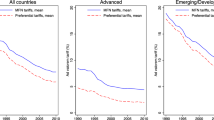Abstract
Under certain conditions, otherwise identical, competing firms may find it jointly preferable to face differing degrees of trade barriers on individual products rather than symmetric trade barriers. The key is the ability to reduce marginal production cost via research and development. The economic significance of this insight is that there could be a role for a market for quota allotments. This insight also has applications to Voluntary Export Restraints in which a priori symmetric, restricted firms may prefer to have individual production levels allocated asymmetrically. This indicates the need for detailed studies of how quotas are met by individual firms.
Similar content being viewed by others
References
Bergstrom, Theodore C.; Varian, Hal R. “Two Remarks on Cournot Equilibria,”Economics Letters, 19, 1, January 1985a, pp. 5–8.
—— “When are Nash Equilibria Independent of the Distribution of Agents' Characteristics?,”Review of Economic Studies, 52, 4, October 1985b, pp. 715–18.
d'Aspremont, Claude; Jacquemin, Alexis. “Cooperative and Noncooperative R&D in Duopoly with Spillovers,”American Economic Review, 78, 5, December 1988, pp. 1133–7.
Matthews, Robert G. “Trade Panel Rules for U.S. Steelmakers,”Wall Street Journal, Tuesday, Oct. 23, 2001, pp. A2, A4.
Meister, J. Patrick.Economic Policies for Process Innovations from Research Joint Ventures, Unpublished Ph. D. dissertation, University of Michigan, 1992.
Newberry, David M. “Acid Rain.”Economic Policy: A European Forum, 5, 2, October 1990, pp. 297–346.
Richardson, J. David. “Trade Policy,” In M. Feldstein (ed.),American Economic Policy in the 1980s, National Bureau of Economic Research: University of Chicago Press, 1994.
Salant, Stephen W.; Shaffer, Greg. “Optimal Asymmetric Strategies in Research Joint Ventures,”International Journal of Industrial Organization, 16, 2, March 1998, pp. 195–208.
—— “Unequal Treatment of Identical Agents in Cournot Equilibrium,”American Economic Review, 89, 3, June 1999, pp. 585–604.
Spencer, Barbara J.; Brander, James A. “International R&D Rivalry and Industrial Strategy,”Review of Economic Studies, 50, October 1983, pp. 702–22.
Author information
Authors and Affiliations
Rights and permissions
About this article
Cite this article
Meister, J.P., Main, R.S. A rationale for meeting quotas asymmetrically. Atlantic Economic Journal 30, 380–384 (2002). https://doi.org/10.1007/BF02298780
Issue Date:
DOI: https://doi.org/10.1007/BF02298780




